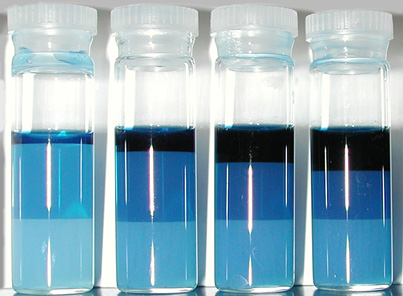Cellulose nanocrystals in water form anisotropic fluids which display the beautiful, well-formed textures characteristic of chiral nematic (cholesteric) liquid crystals, in a phase that is around 90% water and 10% natural cellulose, depending on the axial ratio of the nanocrystals. Close to this critical concentration, the ordered phase is in equilibrium with a more dilute isotropic phase. What happens if polymers are added to the suspension? We have been examining the effect of added dextrans on this equilibrium (Both the nanocrystals and the dextrans are composed of glucose units, thus avoiding strong specific interactions, so that the phase transition should be purely entropic in nature.) We've shown that addition of the polymer blue dextran 2000 (which contains anionic groups) alters the phase separation behavior of aqueous suspensions of cotton cellulose nanocrystals by inducing the separation of an isotropic phase from completely anisotropic suspensions. Neutral, cationic and cellulose-binding anionic dyes did not cause phase separation in the anisotropic cellulose suspensions. What happens if both charged and uncharged dextrans are added to cellulose nanocrystal suspensions? In certain concentration ranges, we were surprised to observe the very unusual formation of three distinct co-existing aqueous phases, two isotropic and one anisotropic (Fig. 1). The range of dextran concentrations at which the triphase equilibrium is produced was strongly influenced by the molecular weight of the blue dextran. Repulsive electrostatic and attractive entropic forces dominate at different concentrations of the dextrans, contributing to the rich phase behavior of these suspensions. ["Triphase equilibria in cellulose nanocrystal suspensions containing neutral and charged macromolecules." Stephanie C. Beck-Candanedo, David R. Viet and Derek G. Gray, Macromolecules, 40(9), 3429-3436 (2007).] In addition to being novel physical/colloid chemistry, the discovery of this multiphase aqueous system based on benign non-toxic components may eventually have applications in biochemical separations.

Three aqueous phases in equilibrium. Cellulose nanocrystal suspension (8.7 wt%) containing commercial blue dextran 2000 (from left to right, number concentration, 0.45 to 2.50X10-6 nm-3) and dextran T-2000 (5.3X10-6 nm-3). Dextran molar mass, ~2x106. The volume fraction of the new upper isotropic phase increases from left to right as more blue dextran 2000 is added.